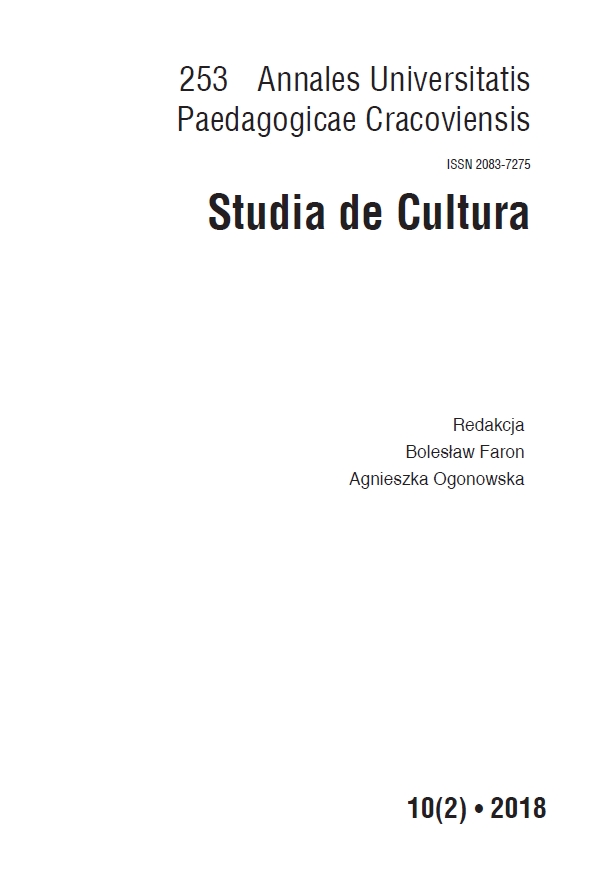Abstrakt
DOI 10.24917/20837275.10.2.7
Głównym celem reportera / fotoreportera jest uchwycenie interesującego, szokującego materiału, który mógłby mieć wpływ na emocje czytelnika. To dlatego bieda, cierpienie i śmierć stają się najważniejszymi tematami, a reporter podąża ich ścieżką, bez względu na to, czy takie działania wydają się moralne, czy nie. Wówczas jednak pisarz może łatwo stracić z oczu swój główny cel, człowieka. Człowieka, który odsłania całą nagą prawdę, odsłania cierpienie, mając nadzieję na poprawę swojego losu istoty, by na koniec zostać porzuconym przez reportera i stać się po prostu jeszcze jedną dobrze sprzedaną historią. Celem mojego artykułu będzie przyjrzenie się amoralnej postawie reportera i relacji: reporter / fotoreporter - główny bohater tekstu. Analiza oparta będzie na najnowszej książce Wojciecha Tochmana - Eli, Eli. Aby bardziej uwypuklić główną tezę artykułu, współczesny reportaż skonfrontowany został z tym z okresu międzywojennego, reprezentowanym przez pionierów reportażu społecznego - Irenę Krzywicką i Wandę Melcer. Celem artykuły jest wskazanie ewolucji gatunku, jego transformacji i ich przyczyn.
A Vulture - the Dark Side of Contemporary Reportage
The main goal of a reporter / photojournalist is to capture some interesting, shocking material, one that would affect the emotions of a reader. Therefore, poverty, suffering and death become the most important, and the reporter follows their path no matter whether such actions seem moral or not. The writer might then easily lose the main focus, a man. A man who reveals all the naked truth, uncovers the suffering, hoping to improve his or her being. At the end, such people are abandoned by the reporter and they become just a well-sold history. The purpose of my paper will be to look closer at the amoral attitude of a reporter and the relationship: reporter/ photojournalist - the main character of a text. My analysis will be based on Wojciech Tochman’s latest reporter’s book - Eli, Eli. To prove my thesis more distinctly, I will confront the contemporary reportage with the one from the Interwar period represented by the pioneers of social reportage - Irena Krzywicka and Wanda Melcer. My goal will be to indicate the evolution of the genre, its transformations and their causes.
Bibliografia
Angyal A. 2005. Wstręt. P. Kołyszko (przeł.). W Psychologia emocji. M. Lewis, J.M. Haviland-Jones (red.). Gdańsk.
Zobacz w Google Scholar
Domańska E. 2008. Badania postkolonialne. W L. Gandhi. Teoria postkolonialna: wprowadzenie krytyczne. J. Serwański (przeł.). Poznań. 157–164.
Zobacz w Google Scholar
Dunin K. 2013. Łagodne postkolonialne safari. http://krytykapolityczna.pl/kultura/czytajdalej/kinga-dunin-czyta/dunin-lagodne-postkolonialne-safari/ (dostęp: 23.05.2017).
Zobacz w Google Scholar
Gadacz T. 2007. Enigma cierpienia. W O umiejętności życia. Kraków.
Zobacz w Google Scholar
Gandhi L. 2008. Teoria postkolonialna. Wprowadzenie krytyczne. J. Serwański (przeł.). Poznań.
Zobacz w Google Scholar
Glensk U. 2014. Stare reportaże uczą pokory. W Historia słabych. Reportaż i życie w Dwudziestoleciu (1918–1939). Warszawa. 11–20.
Zobacz w Google Scholar
Hugo-Bader J. 2014. Długi film o miłości. Powrót na Broad Peak. Kraków.
Zobacz w Google Scholar
Jagielska G. 2013. Miłość z kamienia. Kraków.
Zobacz w Google Scholar
Kopaliński W. 2006. Sęp (hasło). W Słownik symboli. Warszawa. 375.
Zobacz w Google Scholar
Kosowska E. 2008. Wprowadzenie. W Wstyd w kulturze. Kolokwia polsko-białoruskie, t. 2, E. Kosowska (red.). Katowice. 7–8.
Zobacz w Google Scholar
Kristeva J. 2007. Ujęcie wstrętu. W Potęga obrzydzenia. Esej o wstręcie. Kraków. 7.
Zobacz w Google Scholar
Nahirny R. 2005. „Wstyd jako reakcja moralna”. Prace kulturoznawcze IX. Acta Universitatis Wratislaviensis No 2745. 104–115.
Zobacz w Google Scholar
Pietrych K. 2009. Wprowadzenie. Personalne i aksjologiczne wymiary lektury. W Co poezji po bólu? Empatyczne przestrzenie lektury. Łódź. 7–48.
Zobacz w Google Scholar
Rejter A. 2000. Reportaż podróżniczy jako gatunek użytkowy. W Kształtowanie się gatunku reportażu podróżniczego w perspektywie stylistycznej i pragmatycznej. Katowice. 59–87.
Zobacz w Google Scholar
Rozin P., Haidt J., McCauley C. R. 2005. Wstręt. P. Kołyszko (przeł.). W Psychologia emocji. M. Lewis, J.M. Haviland-Jones (red.). Gdańsk. 798–815.
Zobacz w Google Scholar
Sontag S. 2016. Choroba jako metafora. W Choroba jako metafora. AIDS i jego metafory. J. Anders (przeł.). Kraków. 5–86.
Zobacz w Google Scholar
Szczygieł M. 2013. „Afonia i statuetki”. Duży Format. 4.
Zobacz w Google Scholar
Tochman W. 2013. Eli, Eli. Wołowiec.
Zobacz w Google Scholar
Tochman W. 2016. Schodów się nie pali. Warszawa.
Zobacz w Google Scholar
Tochman W. 2008. Jakbyś kamień jadła. Wołowiec.
Zobacz w Google Scholar
Tochman W. 2010. Dzisiaj narysujemy śmierć. Wołowiec.
Zobacz w Google Scholar
Tochman W. 2007. Wściekły pies. Kraków.
Zobacz w Google Scholar

